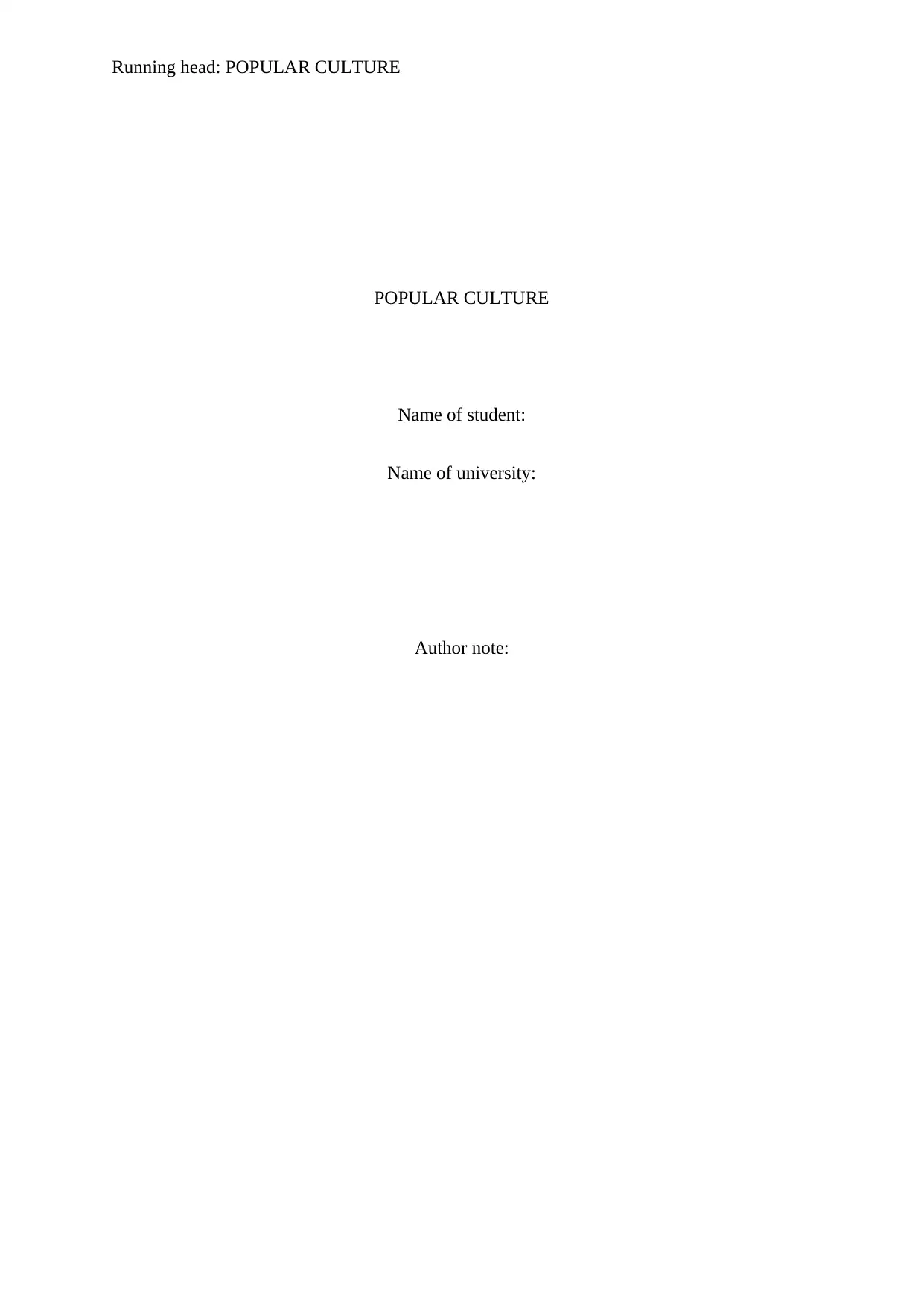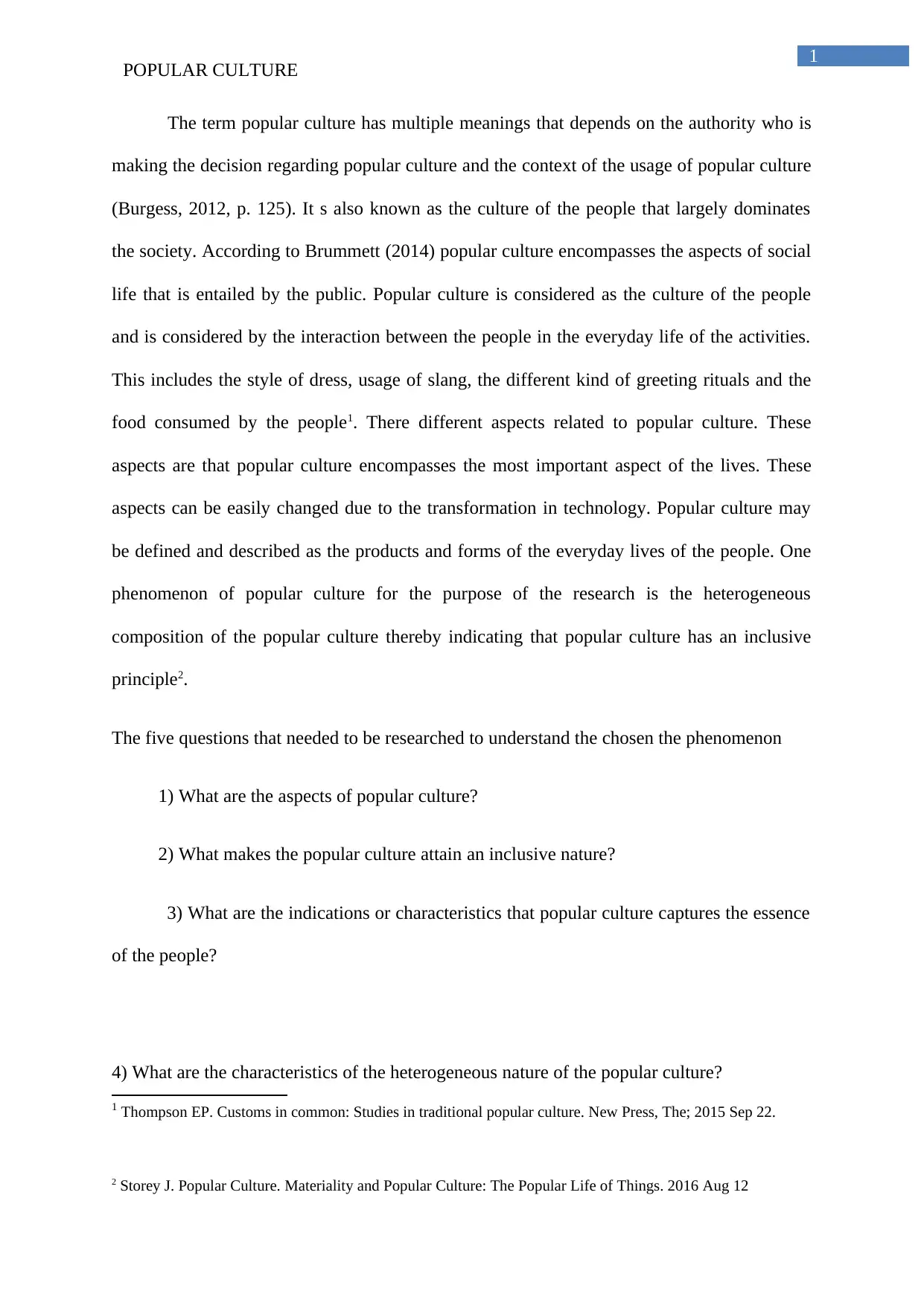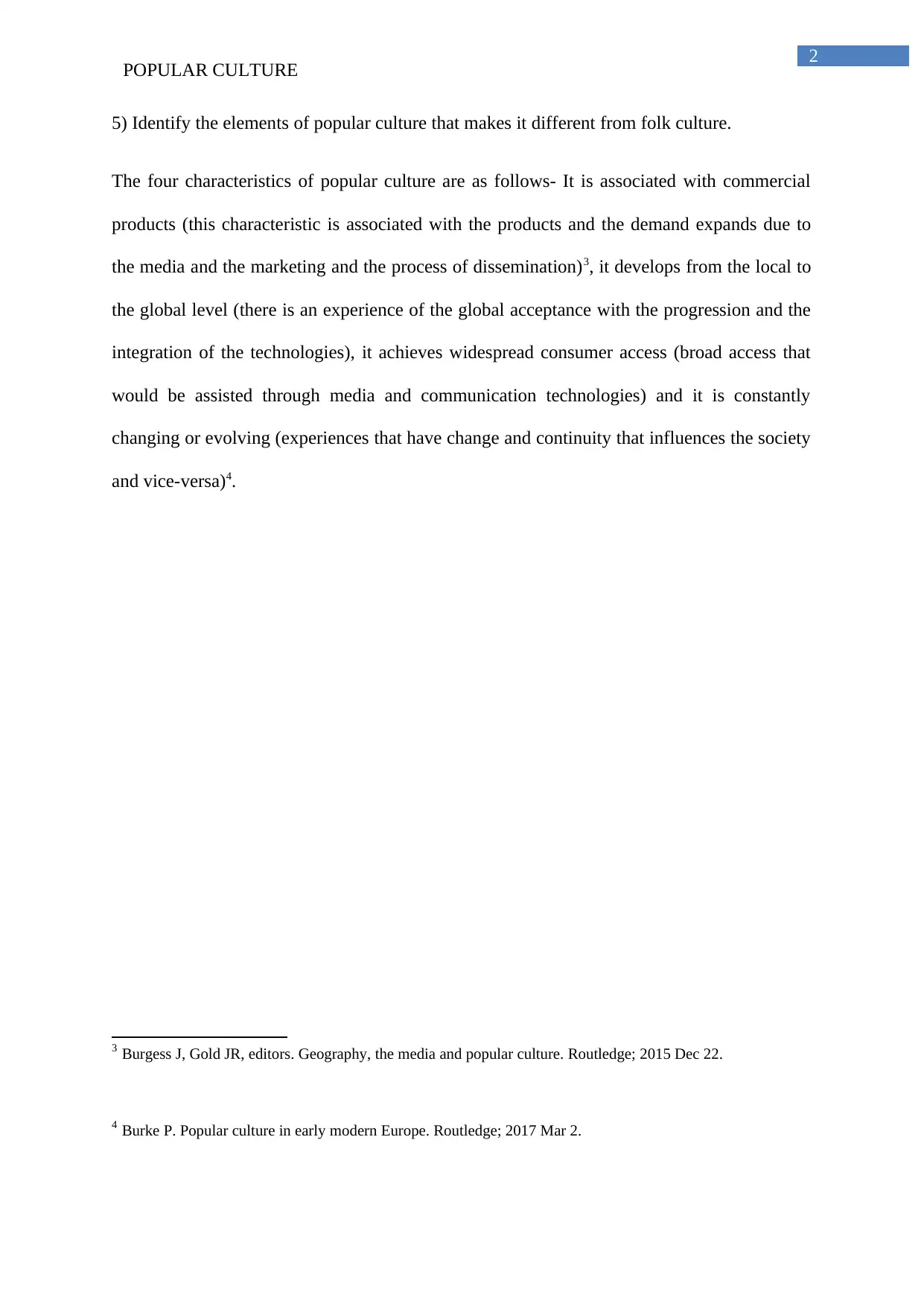Understanding Popular Culture: Aspects, Characteristics, and Differences
VerifiedAdded on 2023/06/12
|4
|615
|109
AI Summary
This article explores the different aspects, characteristics, and differences of popular culture. It discusses how popular culture is defined, its inclusive nature, and how it differs from folk culture.
Contribute Materials
Your contribution can guide someone’s learning journey. Share your
documents today.

Running head: POPULAR CULTURE
POPULAR CULTURE
Name of student:
Name of university:
Author note:
POPULAR CULTURE
Name of student:
Name of university:
Author note:
Secure Best Marks with AI Grader
Need help grading? Try our AI Grader for instant feedback on your assignments.

1
POPULAR CULTURE
The term popular culture has multiple meanings that depends on the authority who is
making the decision regarding popular culture and the context of the usage of popular culture
(Burgess, 2012, p. 125). It s also known as the culture of the people that largely dominates
the society. According to Brummett (2014) popular culture encompasses the aspects of social
life that is entailed by the public. Popular culture is considered as the culture of the people
and is considered by the interaction between the people in the everyday life of the activities.
This includes the style of dress, usage of slang, the different kind of greeting rituals and the
food consumed by the people1. There different aspects related to popular culture. These
aspects are that popular culture encompasses the most important aspect of the lives. These
aspects can be easily changed due to the transformation in technology. Popular culture may
be defined and described as the products and forms of the everyday lives of the people. One
phenomenon of popular culture for the purpose of the research is the heterogeneous
composition of the popular culture thereby indicating that popular culture has an inclusive
principle2.
The five questions that needed to be researched to understand the chosen the phenomenon
1) What are the aspects of popular culture?
2) What makes the popular culture attain an inclusive nature?
3) What are the indications or characteristics that popular culture captures the essence
of the people?
4) What are the characteristics of the heterogeneous nature of the popular culture?
1 Thompson EP. Customs in common: Studies in traditional popular culture. New Press, The; 2015 Sep 22.
2 Storey J. Popular Culture. Materiality and Popular Culture: The Popular Life of Things. 2016 Aug 12
POPULAR CULTURE
The term popular culture has multiple meanings that depends on the authority who is
making the decision regarding popular culture and the context of the usage of popular culture
(Burgess, 2012, p. 125). It s also known as the culture of the people that largely dominates
the society. According to Brummett (2014) popular culture encompasses the aspects of social
life that is entailed by the public. Popular culture is considered as the culture of the people
and is considered by the interaction between the people in the everyday life of the activities.
This includes the style of dress, usage of slang, the different kind of greeting rituals and the
food consumed by the people1. There different aspects related to popular culture. These
aspects are that popular culture encompasses the most important aspect of the lives. These
aspects can be easily changed due to the transformation in technology. Popular culture may
be defined and described as the products and forms of the everyday lives of the people. One
phenomenon of popular culture for the purpose of the research is the heterogeneous
composition of the popular culture thereby indicating that popular culture has an inclusive
principle2.
The five questions that needed to be researched to understand the chosen the phenomenon
1) What are the aspects of popular culture?
2) What makes the popular culture attain an inclusive nature?
3) What are the indications or characteristics that popular culture captures the essence
of the people?
4) What are the characteristics of the heterogeneous nature of the popular culture?
1 Thompson EP. Customs in common: Studies in traditional popular culture. New Press, The; 2015 Sep 22.
2 Storey J. Popular Culture. Materiality and Popular Culture: The Popular Life of Things. 2016 Aug 12

2
POPULAR CULTURE
5) Identify the elements of popular culture that makes it different from folk culture.
The four characteristics of popular culture are as follows- It is associated with commercial
products (this characteristic is associated with the products and the demand expands due to
the media and the marketing and the process of dissemination)3, it develops from the local to
the global level (there is an experience of the global acceptance with the progression and the
integration of the technologies), it achieves widespread consumer access (broad access that
would be assisted through media and communication technologies) and it is constantly
changing or evolving (experiences that have change and continuity that influences the society
and vice-versa)4.
3 Burgess J, Gold JR, editors. Geography, the media and popular culture. Routledge; 2015 Dec 22.
4 Burke P. Popular culture in early modern Europe. Routledge; 2017 Mar 2.
POPULAR CULTURE
5) Identify the elements of popular culture that makes it different from folk culture.
The four characteristics of popular culture are as follows- It is associated with commercial
products (this characteristic is associated with the products and the demand expands due to
the media and the marketing and the process of dissemination)3, it develops from the local to
the global level (there is an experience of the global acceptance with the progression and the
integration of the technologies), it achieves widespread consumer access (broad access that
would be assisted through media and communication technologies) and it is constantly
changing or evolving (experiences that have change and continuity that influences the society
and vice-versa)4.
3 Burgess J, Gold JR, editors. Geography, the media and popular culture. Routledge; 2015 Dec 22.
4 Burke P. Popular culture in early modern Europe. Routledge; 2017 Mar 2.

3
POPULAR CULTURE
References
Burgess J, Gold JR, editors. Geography, the media and popular culture. Routledge; 2015 Dec
22.
Burke P. Popular culture in early modern Europe. Routledge; 2017 Mar 2.
Brummett B. Rhetoric in popular culture. Sage Publications; 2014 Jan 16.
Storey J. Popular Culture. Materiality and Popular Culture: The Popular Life of Things. 2016
Aug 12.
Thompson EP. Customs in common: Studies in traditional popular culture. New Press, The;
2015 Sep 22.
POPULAR CULTURE
References
Burgess J, Gold JR, editors. Geography, the media and popular culture. Routledge; 2015 Dec
22.
Burke P. Popular culture in early modern Europe. Routledge; 2017 Mar 2.
Brummett B. Rhetoric in popular culture. Sage Publications; 2014 Jan 16.
Storey J. Popular Culture. Materiality and Popular Culture: The Popular Life of Things. 2016
Aug 12.
Thompson EP. Customs in common: Studies in traditional popular culture. New Press, The;
2015 Sep 22.
1 out of 4
![[object Object]](/_next/static/media/star-bottom.7253800d.svg)